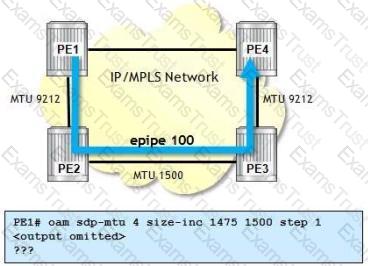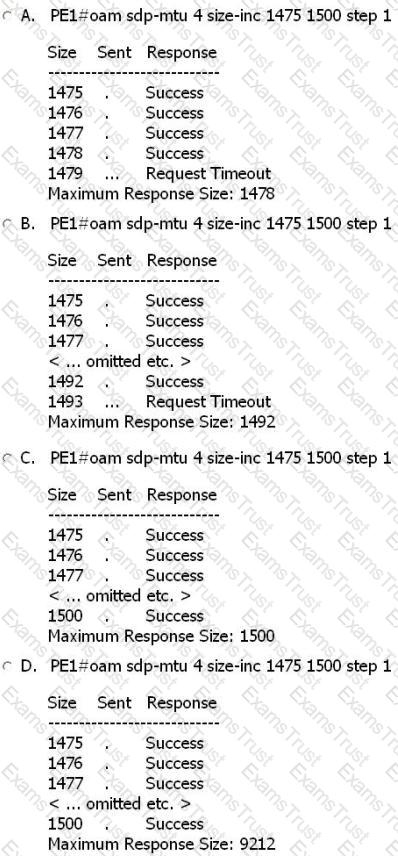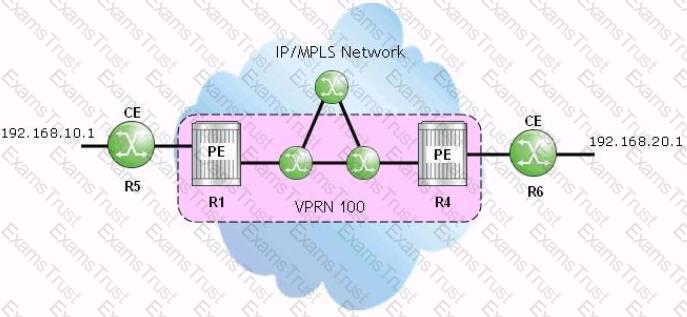Which of the following about 6VPE is FALSE?
Which of the following about route distinguishes on the Alcatel-Lucent 7750 SR is FALSE?
On an Alcatel-Lucent 7750 SR, why must the MTU be explicitly set when configuring an IES spoke termination to a VPLS?
On an Alcatel-Lucent 7750 SR, which of the following statements about the default advertisement of VRF routes is true?
Which of the following is TRUE when a service uses a GRE transport tunnel?
Click the exhibit.

E-pipe 100 is using an SDP (4) with an LSP that uses the path shown (PE1-PE2-PE3-PE4). Which of the following is the expected output from the OAM command?

Which of the following SAPs can be used so that only untagged frames and frames with a VLAN tag of 0 are accepted?
Which of the following about configuring a distributed E-pipe service is TRUE?
Which of the following about VPRNs is FALSE?
By default, what happens when a packet with a VLAN tag is received on a SAP provisioned with null encapsulation?
What command syntax would be used to create a new routed interface on an existing IES service?
Why must the MTU be changed when configuring an IES spoke termination to a VPLS?
Which of the following about transport tunnels used by services is FALSE?
Which service type is needed to bridge an ATM-attached user and an Ethernet-attached user?
Which of the following best describes the flooding of traffic on a PE when unknown traffic is received on a SAP of a VPLS?
Choose the following components that are necessary for the configuration of a mirror service. (Choose 2)
Which of the following about an E-pipe terminating on a VPLS is FALSE?
Consider an E-pipe service configured with SAP 1/1/1:5 and SAP 1/1/1:6. If the SAP 1/1/1:5accepts an ingress frame, which of the following is TRUE?
Which of the following about VPRN route targets is FALSE?
Which of the following about VPRNs is TRUE?
In a Layer 2 encapsulation using T-LDP, what does the second (bottom) label represent?
On an Alcatel-Lucent 7750 SR, what is the recommended approach for making sure that MTUs between a VPLS and its spoke IES termination match?
A VPLS receives a frame with the single VLAN tag 35 on the Q-in-Q SAP 1/1/1:35.*.Which of the following describes default Alcatel-Lucent 7750 SR behavior?
Click the exhibit.

The CEs use BGP and export policies to advertise their local prefixes with the VPRN on their PEs. If the VPRN is functioning properly, which of the following commands will succeed when performed on router R1?
Which of the following is a characteristic of a VPLS?
A VPLS has a service MTU of 1600. To create an IES spoke termination to the VPLS, what ip-mtu value must be used for the IES?
Which of the following about the Isp-ping command on the Alcatel-Lucent 7750 SR is FALSE?
Which of the following statements is TRUE concerning route distinguishes on the 7750 SR?
Which of the following statements are TRUE about configuring a distributed Epipe service? (Choose 2)
Which of the following statements is FALSE regarding 6VPE?
Which of the following defines a SAP that will select frames with an outer tag of '4' and ignore any inner lag on a Q-in-Q encapsulated port?
What is the minimum Ethernet physical network MTU required for a Layer 2 service on a GRE encapsulated SDP with a service MTU of 1514?
In a Layer 2 encapsulation, using Martini, what does the first (top) label represent?
In a Layer 2 VPN service, the FCS is stripped when a customer packet arrives at the ingress PE and regenerated on egress.
A transport tunnel can either use an MPLS or GRE encapsulation.
Which of the following commands is used to configure a new MPLS SDP?
Which of the following statements is FALSE regarding SAPs?
SAPs in an Epipe service can only be configured on Ethernet ports
What are the two major differences between configuring an IES service and configuring VPWS or VPLS services? (Choose 2)
How many SAPs can be configured on a port configured with NULL encapsulation?
Which of the following statements is NOT a valid reason to use MP-BGP as a routing protocol to transport VPRN routes?
Which of the following statements best describes the flooding of traffic on a PE when traffic is received on a spoke SDP?
Which service is needed to bridge an ATM service to an Ethernet service?